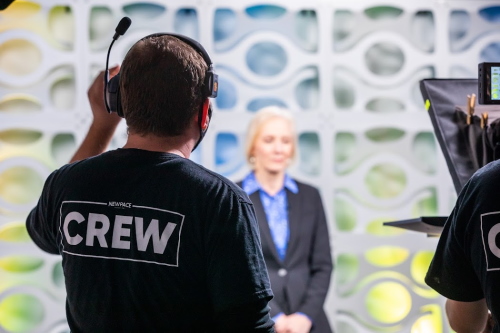Now more than ever, companies need visibility. Video content is so popular and effective that 92% of marketers believe it must be an important part of a modern marketing strategy. Yet, even though video brilliantly brings concepts to life, captures attention, engages viewers, and has the power to persuade an audience, 23% of marketers say that they don’t use video because they lack the time to produce it. Others are worried that any video production could upend their budgets.
Repurposing video content will not only increase the reach of your existing video content, but it is also a smart way to build a library of footage that can be reused. Repurposing increases shelf life and presents critical messaging in many ways to new audiences.
4 Smart Reasons for Repurposing Video Content
- You’ll Reach a Wider Audience
People consume information in different ways. Once you create content for your target audience on a single platform, you’ll want to reach other audiences as well. By repurposing your video content across multiple platforms, you’ll not only reach more viewers, but you’ll also engage a wider, more diverse audience — plus boost reach and visibility on search engines.
- You’ll Strengthen Your Messaging
Are you familiar with the Rule of Seven? It’s a proven marketing principle that says a message won’t even register with prospects until they hear or see it at least seven times.
Content repurposing reinforces your messaging by letting your audiences see and hear it in different ways, which makes a greater impact.
- You’ll Boost Return on Investment
When you find new ways to reuse existing content assets, you’re putting them to good use at a much lesser cost. Repurposing content is a great way to improve return on investment (ROI) and conversion rates to deliver better results.
- You’ll Establish Thought Leadership
Consistent messaging on the same topic in exciting, refreshing, and diverse ways is an effective way to be recognized as a credible expert on the subject. This can enhance your reputation, boost awareness of your company, and increase public trust in your brand.
One Video, 10 Ways to Repurpose It
Repurposing video content means taking one video asset and reusing it somewhere else. What’s even better is to produce video content with the goal of repurposing it in mind, so you can make it go the extra mile in different formats for different platforms.
Whether you’re hiring a video production company to shoot your video or you’re shooting it yourself, it is totally possible to create 10 pieces of content from one video.
Here are some ideas:
1. Long-Form Video
Think of a great topic that your company can speak to and find the most-asked questions from your clients, customers, patients, or students. Have at least two experts from your company discuss the topic or answer the questions and record them doing it.
Create a script from your video content that tells the story of your company and have editors produce a five- or eight-minute corporate video. Post it on your website’s pages and landing pages.
2. Snackable Clips
Break down a master video (like the long-form video you produced above) into shorter videos that can be shared across other platforms such as social media outlets like Facebook. Create the clips around specific talking points and messaging or create teasers that generate buzz and encourage followers to view the entire video. Focus each snackable video on a single communication that grabs attention and gets your message across effectively.
3. Blog Posts
Convert a video into a blog post by transcribing the video and editing the content to suit your blog readers. Add more value by elaborating on pain points, including relevant research or thought leadership. Include visuals made from screengrabs, GIFs (Graphics Interchange Formats), or video clips. Embed the video into the blog or give readers a link to the original video. Remember to optimize the blog post for SEO to boost search engine rankings.
3. Social Media Graphics
Pick out important points, quotes, or statistics from your video that are quick to consume and design graphics for Twitter, Facebook, Instagram, LinkedIn – any social media platform where you want to engage an audience. You can also create eye-catching animated GIFs to add more context and easily connect with your audience.
4. Graphic Visualizations
Graphic visualization is another phrase for an infographic — a popular content type that presents complex information in a digestible format. Maximize the viewership of your video content by repurposing it into a graphic visualization. To do this, condense the information presented in the video by choosing data points, steps of a process, key findings, or trends that translate the overall message graphically.
5. SlideShare Presentations
SlideShare lets people upload and share presentations. You can upload your video on SlideShare or repurpose it to suit the medium by creating short, simple, and visually appealing SlideShare decks that reiterate your message.
6. Email Content
To deliver informative, engaging emails to subscribers consistently, repurpose existing video content for use as email content. For instance, create an email series around your snackable clips. You can embed them and create content around them for your emails, or the emails can send readers to the original video for viewing.
7. Podcasts
Podcasts are a type of immersive content that is becoming more popular; 22% of Americans listen to podcasts at least once a week. Repurposing your video’s audio as a podcast can help you reach a wider audience, which can increase brand loyalty. Since podcasts are expected to be longer than your average video, elaborating on the message will add more value.
8. Video FAQs
Instead of the traditional Frequently Asked Questions webpage, answer FAQs with video content. You’d also be able to upload your video answers to an Amazon listing and use them for posting on social media or as a video ad.
9. Instagram Stories and TikTok
Instagram Stories are formatted as vertical video, and they’re no longer than 15 seconds. TikTok videos are also vertical, and they’re 15 seconds to one minute long. If your existing content is in a horizontal format, you’ll need to convert it to vertical before repurposing it.
10. Facebook Cover Videos
People often visit your company’s Facebook profile to see what kind of engagement you get and what people are saying about you. Since the cover is the first thing they see, repurposing video content as your Facebook cover can have a positive impact on your Facebook visitors.
Bonus: Create YouTube Playlists for Repurposed Video Content
YouTube gets your video content discovered by creating backlinks. Uploading all of your video content to YouTube can be an advantage, but you don’t want to clutter your YouTube page with what may look like random content.
Create dedicated playlists for multiple subjects and upload your videos there. Include areas such as product demos, customer testimonials, live social shows, webinars, etc. Include all the right keywords in the tags and description of each video too.
Need Help Repurposing Video Content?
Let us help you get a jump on your video production and stretch your budget in the smartest and most effective way. Download our tip sheet for secrets videographers use to shoot professional videos that you steal when shooting on your phone.
You’ll learn how to:
- Get the best sound and lighting
- Choose the best background for your shot
- Use the right aspect ratio for your video
- Avoid that “shaky cam” effect
Need help with content optimization? New Pace Productions can give you the assist! Contact a video strategist today!






